Retellings as a Valuable Response to Literature
by Kathryn Bolasky, Kindergarten Teacher, Van Horne Elementary School
Retellings are the most common way in which kindergarten students respond to a text, often by excitedly sharing their favorite part of the story. Educators and researchers view retelling as a beginning, or less sophisticated response, at the bottom of the hierarchy of types of responses. Retellings are seen as reflecting only surface level understandings of a text through fairly literal recountings of what students have read (Miller, 2002, p. 163). When looking at my students’ responses to text across the year, I realized that retellings served a wider range of purposes for my students and were a meaningful response that was pivotal in developing their thinking skills. In examining their retellings, I found six different categories of the kinds of thinking that my students engaged in through their retellings. Each type of retelling provided different insights on how the students were making meaning of the texts in which they were engaged.
Recounting Individual Plot Events
Many of my students responded to stories by recounting an event from the story. These retellings were straightforward and literal. The events that the students depicted were not events that were not necessarily central to the story plot. They were details of the story that they remembered. For example, after hearing Tight Times, by Barbara Shook Hazen (1979), about a family experiencing difficult financial struggles, Matthew drew a picture of the cat eating lima beans and the mother in the story giving the son a candy bar when his father is upset. He dictated, “This is the cat eating lima beans. The mom is giving the boy a candy bar because the Dad is sad.” Cherise responded similarly to Smoky Night, by Eve Bunting (1997), about riots in Los Angeles. Cherise drew a picture of a house burning and the church that served as a shelter. When I asked her what she was drawing she said, “This is the fire on the house. This is the church that the people slept at.”
Although these retellings might not appear to reflect deeper understandings of the books, they do provide insights into what the students attended to or remembered from the story. Students were not able to tell why they chose these details, and so I still wonder whether these details might be connected to deeper understandings than initially appears evident.
Enjoying Humorous Plot Elements
Retellings can sometimes demonstrate parts of the story that the students thought were funny or humorous. After hearing The Book of Mean People by Toni and Slade Morrison (2002), Nicholas responded to the part of the story when the character, a bunny, takes off his clothes. When asked about his drawing, he said, “I liked the part where he took off his clothes and stretched because it was funny.” Similarly, after the read aloud of Tight Times (Hazen, 1979), Anton responded by depicting a humorous part of the story. He drew a cat eating lima beans and dictated, “This is the part when the cat likes lima beans.”
Neither Nicholas nor Anton responded to a central part of the story or in a way that related to the overall theme, but they were able to communicate their enjoyment of the story. They were able to share events in the story that they felt were funny, which in turn helped me to better understand what they enjoy as readers. I was able to use this information in my planning and in book selection.
Connecting to Personally Significant Plot Elements
Many of the retellings that my students created depicted parts of the stories that they found personally significant. Students produced responses that indicated what they saw as the most important part of the story. More often than not the students’ opinions of what was important were events that adults might easily dismiss or overlook. Their responses provide a lens to understand what my students were thinking about the story. Tight Times (Hazen, 1979) was a particularly significant text in changing the way that I viewed my students’ responses. Many of the students created responses around the part of the story where a woman helps the young boy rescue a stray cat from a garbage can. This event was not the most significant event in relation to the theme of the story, a family dealing with job loss and tough economic times, but it was significant for the children. When Ricky and Hayden decided to draw a picture depicting the woman helping the boy, they were demonstrating their connection to this event. They understood that the cat needed help and that it was both the woman and the little boy’s responsibility to provide that help. Ricky said, “The girl helped the cat get out. It was nice to do that.” Hayden said, “The lady is getting the cat out of the trash can. It’s important because it’s nice.”
These responses might be easily dismissed as simple retellings of an event from the story, but I feel they are powerful. Although the students did not relate to the problem of tight economic times, they did connect to another type of problem, providing help to someone in need. Both boys demonstrated an understanding of a problem to which they could personally connect. I believe that they responded to this event, and not the father losing his job, because they could easily see themselves helping an abandoned cat, but not helping their fathers find a new job. The father being laid off was an abstract concept, but helping an abandoned cat was concrete for the boys. Given our school focus on kids taking action for a better world, focusing on a child taking action in their retelling takes on even more significance.
Highlighting a Turning Point or Important Plot Elements
As the year progressed, I noticed a shift in the students’ retellings. Students began to identify major turning points in the plot development in their responses. This was an important step in their thinking in the sense that it showed me that they were able to identify important parts of the story, even though they were not able to explain why the event was important. Reyna’s shift in thinking occurred after listening to Smoky Night by Eve Bunting (1994). She responded by not only drawing an important event from the beginning of the story, but also one from the end. Her paper was divided by a fold vertically down the middle. On the left side she drew a picture of the people rioting and stealing from the houses and businesses. She dictated, “They are taking a door and a TV.” On the right side of the paper she drew a picture of firefighters returning the cats to the young boy and his neighbor. Her dictation for this picture was, “This is when the fireman brought their cats back.” Reyna’s ability to depict two important events from one story showed me that she was beginning to think about the read alouds more deeply. She was not just thinking about which part she liked or thought was important. She was thinking about what was happening in the story and what parts were important to the central focus of the story.
Anton created a significant response to Smoky Night by drawing a multi-color picture of the two cats. When asked what he was drawing he responded by saying, “This is a picture of the cats getting to know each other.” As I was reviewing this response, I realized that his comment was not an actual event from the story. Anton understood that the event at the end of the story when the cats are friendly was significant. He took that event and his own experiences of getting to know someone and created an implied event in his response. He was able to think about the process of becoming friends and use it to think about the cats getting to know each other. This was significant in the sense that the cats becoming friends reflects the main theme of the story. By responding to this important event, Anton demonstrated his understanding of the big idea of the story, not judging others before you take the time to get to know them, without putting the idea into those exact words.
Narrating the Main Points of the Story
In some cases responses that are retellings can be narratives of the main point of the story. LaFon Phillips (1999) argues that students can create retellings through narratives and storytelling (p. 368). In many cases the dictations I was taking from students were narratives that they created to explain their thinking about the story. Not all of the narratives were long and involved; they ranged from one to three sentences. For example, after reading The Book of Mean People, Sarah drew a picture of a sad boy. She dictated the following sentences that narrated her understanding of the story, “This is a picture of the boy being sad. Someone was mean to him.” These simple sentences tell the main point of the story. Another example of a narrative retelling is Zachary’s response to Peach Heaven (Choi, 2005). He drew a picture of the girl standing with peaches and said, “The girl was smiling because she was kind of happy. She was kind of happy because it was raining peaches and she was sad because the farmers worked so hard.” Zachary demonstrated a sound understanding of the big idea of the story through his retelling as well as comments on both the villagers’ and the farmers’ perspectives.
Garrett used retelling to explain his understanding of malnutrition. After hearing Tight Times, Garrett responded to the popular part of the story, the cat rescue, but he took it one step further. Like many of his classmates, Garrett drew a picture of the cat in the trash can and the boy and the woman helping get it out. Garrett’s dictation demonstrates his understanding when he says, “The boy found the cat. If he didn’t find it, it would be lost forever and never get found. It could get very sick if it doesn’t get any food.” Garrett was able to get past just saving the cat because it was a nice thing to do. He explained that the cat was in danger of starving or getting sick if left in the trash can. This retelling connected not only to the story but to the concept of hunger which we were studying at the time.
Exploring Cause and Effect through Retellings
A few of my students were able to show cause and effect relationships between events in the story through retellings. Cause and effect relationships are not easily identified by kindergarteners, making these responses significant. After hearing Smoky Nights, Hayden, Abdoul, and Damon responded by showing the cause and effect between events from the story. Hayden divided his paper in half vertically and showed the cause and effect of the rioting. On the left side, he drew a picture of a person and dictated, “This is the bad guy who took the money.” On the right side, he drew a dark wall and a door and explained, “This is an empty house after the bad guy took everything.” Hayden was able to understand that “the bad guy” caused the house to be empty. Abdoul depicted the house burning and the people having to escape, saying, “The house is on fire. These are the people running scared and hurt.” This response was powerful and significant for Abdoul in the sense that he is an English language learner and rarely completed responses to read alouds. He demonstrated that he understood that the fire was what caused the people to leave their houses. Damon also responded to the burning buildings and explained his drawing by saying, “These people broke the house and put it on fire. They got a lighter and burned it. These are the people escaping.” Both Abdoul and Hayden were able to show that they understood that other people, the rioters, caused innocent people harm. Identifying cause and effect relationships is a difficult skill to learn, yet through these retellings I am able to see evidence that a few of my students understand the concept.
Conclusion
For my students, retelling was more than just repeating lines or parts of the story, it was a way to make meaning of the text that we were reading. Responding through retelling allowed my students to demonstrate what they thought and learned from each story. As a teacher, it was important for me to return to each book as a context for reviewing and understanding their retellings. Without thinking about the big ideas from the story or the reason for using a text, the retellings can be easily confused as basic summaries. I realized that there are a tremendous range of types of retellings and that closely examining each retelling provides insights into how my students are thinking about and connecting to literature. Each type of retelling served as a valuable planning tool due to the insights I gained into their thinking.
References
Bunting, E. (1994). Smoky night. Ill. D. Diaz. San Diego: Voyager.
Choi, Y. (2005). Peach heaven. New York: Farrar, Straus & Giroux..
Hazen, B. (1979). Tight times. Ill T. Hyman. New York: Puffin.
Hume, L. (2007). Clancy the courageous cow. New York: Greenwillow.
Miller, D. (2002). Reading with meaning. Portland, ME: Stenhouse.
Morrison, T. (2002). The book of mean people. Ill. P. Lemaitre. New York: Hyperion.
Phillips, L. (1999). Pathways to understanding. Tucson, AZ: Unpublished doctoral dissertation, University of Arizona.
WOW Stories, Volume I, Issue 3 by Worlds of Words is licensed under a Creative Commons Attribution-NonCommercial-ShareAlike 4.0 International License.
Based on a work at https://wowlit.org/on-line-publications/stories/storiesi3/.

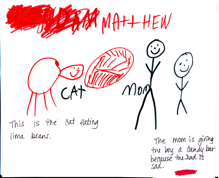
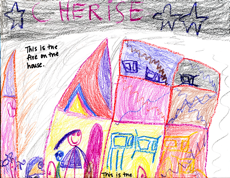
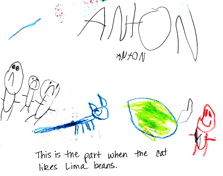
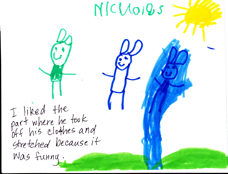
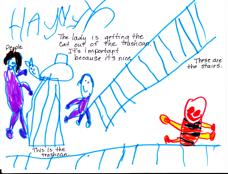
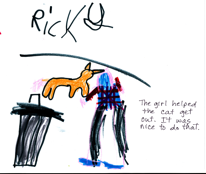
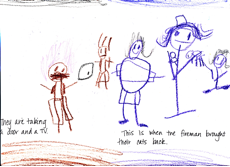
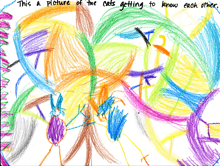
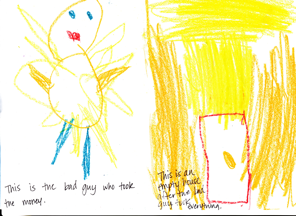
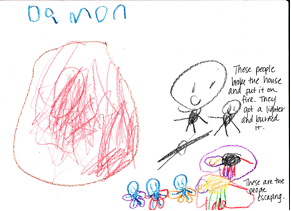
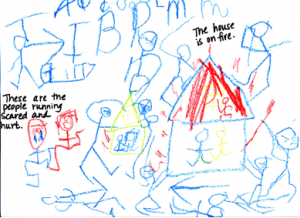
One thought on “WOW Stories: Connections from the Classroom”
Comments are closed.